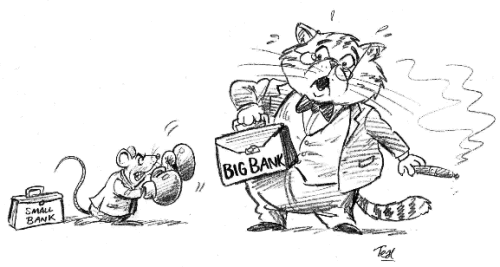
I was reading about banks being average to poor at marketing, and wondered about it. Banks’ advertising generally is about either being cool or in love with you. Here are a few examples from British banks.
Lloyds: we’re old but still here with a big horse
Nationwide: we have no pretensions because we are a mutual
Barclays: we’re going to make you worried, but you can worry securely
NatWest (RBS): we’re going to make you cry, but you can cry securely
Santander: we’re ... urmmm, well ... urmmm, we're here
What’s interesting watching these ads is that they’re not about money, but about life and online security. In fact, they’re just about branding.
The reality is, as I was discussing the other day in building a customer-centric bank, that the banking culture has been founded on pushing products through channels. The UK PPI farce and US Wells Fargo account openings scandal are good examples of that culture and mentality. It is driven by objectives built to get the maximum share of wallet out of the customer through cross-selling. It focuses upon waiting for the customer to make mistakes, and then punish them for it. It is an inside-out view of the world, and does not appear to have the customers’ best interests at heart.
However, because the customer believes all banks are the same and there’s little difference, they feel that they don’t have a choice.
Because they don’t think they have a choice, they don’t care. They just use whoever they happen to have an account with, and get on with life.
Now this is changing, and it’s changing due to so many start-up companies starting with the customer in mind. This is the mentality of the UK challenger banks: building a new bank based upon customer journeys. Will this change behaviours? Will people switch? I’m not sure, but CB Insights had a fascinating write-up on the early developments of the challenger banks the other day, and some of these charts are very telling:


What I’m particularly interested in is the chart of customers opening accounts. The lighter the offer, the more the customers. For example, Revolut is mainly a payments app for easy cross-border and P2P payments, and opened the most accounts. Monzo began with purely a prepaid card and no bank account, and onboarded a significant number of customers. But the banks with a full banking licence have been slow to catch-on.

I think this is because making a payment or topping up a prepaid card is far easier for young people to grasp than switching their whole banking service. What would make me switch? I guess if there was an amazing curated marketplace of financial services through APIs brought to me by the bank.

Oh!
And the bottom-line: the new world of banking focuses on the customer, the customer's journey, the customer's needs and aims to fulfil them by designing from their with partnerships where needed. They do not punish the customer for making mistakes, but try to help them avoid making mistakes and rewarding them for doing so. That is what customer-centric banking is all about and it will be interesting to see how the big boys change and adapt to keep up.
Chris M Skinner
Chris Skinner is best known as an independent commentator on the financial markets through his blog, TheFinanser.com, as author of the bestselling book Digital Bank, and Chair of the European networking forum the Financial Services Club. He has been voted one of the most influential people in banking by The Financial Brand (as well as one of the best blogs), a FinTech Titan (Next Bank), one of the Fintech Leaders you need to follow (City AM, Deluxe and Jax Finance), as well as one of the Top 40 most influential people in financial technology by the Wall Street Journal's Financial News. To learn more click here...

